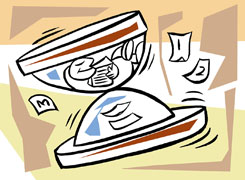39 year old with 90K salary and 15K rental income looking for retirement planning advice
Ramalingam Kalirajan |10894 Answers |Ask -Follow
Mutual Funds, Financial Planning Expert - Answered on Jan 10, 2025
He has an MBA in finance from the University of Madras and is a certified financial planner.
He is the director and chief financial planner at Holistic Investment, a Chennai-based firm that offers financial planning and wealth management advice.... more

I am 39 and My in-hand salary is 90K and additional rental income of 15k from my house (loan free), which will start from next month. My current monthly expenses are around 50K. I have PPF balance of 14 lakhs and a PF (including VPF) balance of 10 Lakhs, contributing 1.5 Lakhs to PPF annually and 2.3K to PF and 10.2K mothly to VPF respectively. Also have an FD of 1.5 Lakhs. I am new to MF and have started investing since last April. My MF balance is 1.23 lakhs, details of which are as ICICI Prudential Nifty 50 index fund - 5000 p.m. Parag Parikh Flexi cap fund - 2000 p.m. Quant Small cap fund - 2000 p.m. UTI Nifty 500 value 50 index fund - 2000 p.m. ICICI Prudential Bharat 22 FOF scheme - 1500 p.m. ICICI Prudential Retirement Fund - Hybrid aggressive - 3000 p.m. Looking for advise for two questions : 1. what will be the decent retirement corpus. my investment horizon is long term, around 22 years. looking to accumulate around 6-7 crores. is it possible.? 2. My MFs are underperforming, do I need to change any allocation. ?
Assessing Current Investments
You contribute regularly to PPF, VPF, and MFs, which is commendable.
Your existing corpus of Rs 25.23 lakhs (PPF, PF, FD, and MF) gives a strong start.
Rental income adds flexibility for investment, as it is a steady source.
Required Corpus and Growth
A corpus of Rs 6–7 crores in 22 years is realistic with consistent investing.
Equity investments can provide high growth for your long-term goals.
Fixed-income instruments (PPF, PF, FD) ensure stability but may need rebalancing.
Suggested Allocation for Corpus Growth
Allocate higher portions to equity for compounding and inflation-beating growth.
Continue PPF and VPF contributions for stability and tax benefits.
Increase equity MF investments gradually to balance the portfolio.
Improving Your Mutual Fund Portfolio
Your MF portfolio needs evaluation to align with your goals and risk tolerance.
Issues with Current Portfolio
Two index funds and a Bharat 22 FOF reduce your growth potential.
Index funds offer average returns, which underperform actively managed funds.
Actively managed funds can provide better returns with professional management.
Recommendations for Portfolio Adjustment
Exit index funds and Bharat 22 FOF. Redirect these amounts to high-performing equity funds.
Keep Parag Parikh Flexi Cap for its strong track record and diversification.
Retain Quant Small Cap for long-term growth potential, but monitor volatility.
ICICI Prudential Retirement Fund is acceptable, but evaluate its performance periodically.
Benefits of Actively Managed Funds
Active funds are managed by experienced professionals who aim to outperform benchmarks.
These funds adapt to market conditions and maximise growth opportunities.
A Certified Financial Planner can help select funds aligned with your goals.
Disadvantages of Index Funds
Index funds simply mirror the market and lack flexibility in stock selection.
They underperform in volatile markets as they cannot avoid poor-performing stocks.
Actively managed funds are better suited for long-term goals like retirement.
Taxation and Investment Planning
Review taxation rules to minimise tax liabilities on your returns.
Equity MF LTCG above Rs 1.25 lakh is taxed at 12.5%; STCG is taxed at 20%.
Debt funds are taxed as per your income slab, reducing post-tax returns.
Steps to Achieve Rs 6–7 Crore Corpus
Invest an additional Rs 15,000–20,000 monthly from your rental income in equity MFs.
Increase your SIPs annually by 10–15% to match income growth.
Maintain diversification across large-cap, flexi-cap, and small-cap funds.
Avoid over-allocation to low-growth instruments like FD and Bharat 22 FOF.
Monitoring and Reviewing Portfolio
Review your portfolio with a Certified Financial Planner every year.
Rebalance allocations based on performance and market conditions.
Exit underperforming funds and shift to better options when necessary.
Final Insights
Your goal of Rs 6–7 crores is attainable with disciplined investing and portfolio adjustments. Increase focus on equity funds for long-term growth while retaining stable instruments like PPF and VPF. Monitor your portfolio and seek professional guidance for optimal results.
Best Regards,
K. Ramalingam, MBA, CFP,
Chief Financial Planner,
www.holisticinvestment.in
https://www.youtube.com/@HolisticInvestment
You may like to see similar questions and answers below
Omkeshwar Singh | Answer |Ask -Follow
Head, Rank MF - Answered on Sep 19, 2022
Ramalingam Kalirajan |10894 Answers |Ask -Follow
Mutual Funds, Financial Planning Expert - Answered on May 05, 2024
Ramalingam Kalirajan |10894 Answers |Ask -Follow
Mutual Funds, Financial Planning Expert - Answered on May 29, 2024
Ramalingam Kalirajan |10894 Answers |Ask -Follow
Mutual Funds, Financial Planning Expert - Answered on Jul 11, 2024
Ramalingam Kalirajan |10894 Answers |Ask -Follow
Mutual Funds, Financial Planning Expert - Answered on Oct 27, 2025
Patrick Dsouza |1429 Answers |Ask -Follow
CAT, XAT, CMAT, CET Expert - Answered on Dec 16, 2025
Nayagam P P |10858 Answers |Ask -Follow
Career Counsellor - Answered on Dec 16, 2025
Nayagam P P |10858 Answers |Ask -Follow
Career Counsellor - Answered on Dec 16, 2025
Samraat Jadhav |2510 Answers |Ask -Follow
Stock Market Expert - Answered on Dec 16, 2025
Samraat Jadhav |2510 Answers |Ask -Follow
Stock Market Expert - Answered on Dec 16, 2025
Nayagam P P |10858 Answers |Ask -Follow
Career Counsellor - Answered on Dec 16, 2025
Nayagam P P |10858 Answers |Ask -Follow
Career Counsellor - Answered on Dec 16, 2025
Ramalingam Kalirajan |10894 Answers |Ask -Follow
Mutual Funds, Financial Planning Expert - Answered on Dec 16, 2025
Nitin Narkhede |113 Answers |Ask -Follow
MF, PF Expert - Answered on Dec 15, 2025
Nitin Narkhede |113 Answers |Ask -Follow
MF, PF Expert - Answered on Dec 15, 2025




























